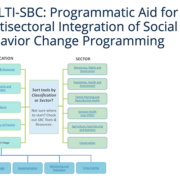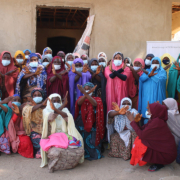Integrating SBC Across Sectors: Barriers, Enablers, and New Tools to Find Resources
Written by: Sriram Sridharan, Associate, and Stephanie Levy, Senior Associate, Breakthrough ACTION
Well-established linkages between outcomes in family planning (FP) and other development sectors can be leveraged by integrated social and behavior change (SBC) programs. However, as the evidence from integrated programming accumulates, professionals working on multisectoral SBC integration must strengthen these linkages through systematic, coordinated efforts to disseminate programmatic findings; share useful tools and instruments; and communicate enablers and barriers to integration in funding, design, implementation, and evaluation. A new Breakthrough ACTION report outlines enablers and barriers relevant to integration across multiple development sectors. Examples of enablers include shared target populations, one development sector providing a convenient entry point to other sectors and engaged community stakeholders. Among the barriers are siloed funding streams, lack of relevant SBC evidence, and disconnected team structures in multisectoral projects.
Another commonly cited barrier, faced by both new and experienced practitioners, is difficulty in identifying and accessing relevant tools and instruments. These desired resources include evidence repositories, guides to design and implement social norms interventions, SBC frameworks, strategy documents, indicator lists, and program results. Such resources are often disseminated shortly after production but can be difficult to find later on. So, despite the existence of a significant number of SBC resources supporting multisectoral integration, practitioners still struggle to find what they need, when they need it. To address this, Breakthrough ACTION developed MULTI-SBC, a web-based repository that helps SBC professionals easily locate a range of current, relevant SBC resources, to be updated on a regular basis. The resources housed on this platform are cross-categorized by development sector (e.g., agriculture, food security, and nutrition; population, health, and environment; democracy, rights, and governance) and specific project stages (project design; implementation; monitoring and evaluation), allowing practitioners to narrow their searches to resources best fitting their needs.
Additionally, a new Trending Topic on SBC Multisectoral Integration, available through the Compass, provides great examples of multisectoral integrated programs, and useful resources for practitioners interested in integration. This Trending Topic features a selection of the materials documenting the work done by these integrated programs, as well as some of the resources housed on MULTI-SBC.
Breakthrough ACTION invites you to share your experiences using MULTI-SBC and provide feedback that could be used to improve it. Check out the resources today and let us know how you use the platform!

 Erly Tatontos/World Bank/Flickr
Erly Tatontos/World Bank/Flickr


 Breakthrough ACTION
Breakthrough ACTION Jonathan Torgovnik/Getty Images/Images of Empowerment
Jonathan Torgovnik/Getty Images/Images of Empowerment